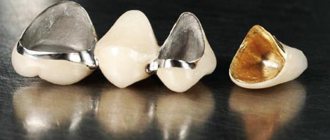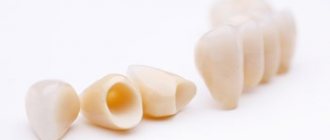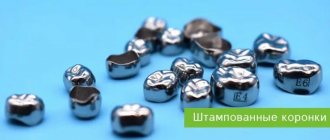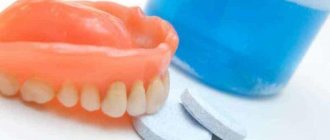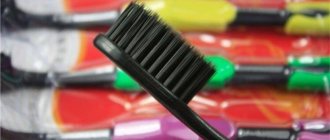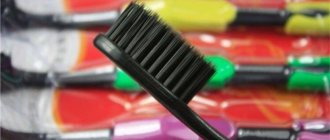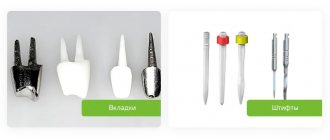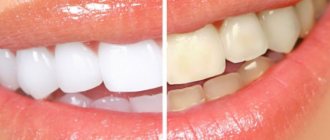Metal dental crowns are about 0.3-0.5 mm thick. This layer is removed from the tooth surface so that it does not stand out against the background of the rest of the teeth.
Such crowns are made in two ways: stamping and casting. In the latter case, the specialist needs to obtain an impression of all teeth in order to perform the work with absolute accuracy.
For all-metal crowns, modern dentistry uses all kinds of alloys: gold, platinum, silver-palladium, steel and steel with gold plating, chromium-cobalt. Each of the listed metals has its own advantages and disadvantages.
For example, gold crowns were recently considered a sign of wealth and security. Despite this, their properties leave much to be desired. Gold is a fairly soft metal, and therefore is prone to rapid abrasion, which can subsequently injure the tooth itself. Therefore, experts recommend paying attention to crowns made of more reliable alloys.
Titanium alloys, as well as alloys of gold and platinum, gold and palladium, have excellent strength, resistance to abrasion and mechanical stress. In addition, they are famous for their excellent anti-corrosion properties. The only drawback of such precious crowns is their price. Not everyone can afford such luxury.
Fortunately, there are less noble but more durable metals. They are often used for prosthetics of molars, since they are able to withstand high loads when chewing.
Metal crowns on teeth do not tolerate foreign “neighborhood”. Using several types of metal at the same time can cause a number of negative chemical reactions, as well as a burning sensation and a metallic taste in the mouth.
Why should you install metal crowns on your teeth?
Among the unconditional advantages of metal dental crowns, one can immediately highlight their relative durability, strength, and the impossibility of chipping. There are a number of other positive aspects associated with certain types of metal:
- gold crowns are adjusted to the existing tooth with anatomical precision;
- precious metals do not wear away the opposing tooth;
- titanium crowns are absolutely non-toxic, therefore they are often used in pediatric dentistry;
- ordinary crowns have a low price with excellent quality;
- The installation of such a crown is quite simple and does not require preliminary complex treatment of the tooth.
In addition, if a golden shade is important to you, but you don’t have the money, you can always install coated metal crowns.
The reverse side of a coin or the negative sides of metal crowns
Despite the many advantages of tooth restoration with metal crowns, there are also a number of disadvantages:
- absolutely unattractive appearance, so it is recommended to place metal crowns only on chewing teeth;
- stamped crowns have a small gap between the gum and tooth, which as a result can lead to caries, inflammation, bad breath, and other troubles;
- a regular alloy can cause a number of allergic reactions in the body, so it is important to undergo appropriate examinations first.
When choosing an old, proven method of prosthetics, do not neglect consultation with a specialist. Only he can determine which method will be optimal for the health of your smile.
Structural features
Any coated metal crown is a one-piece construction. Previously, they were produced according to a standard sample, and then the doctor had to “adjust” the system to the characteristics of the patient’s oral cavity. Of course, this was difficult to do. Today the situation is different - all prostheses are made exclusively from individual casts, so little or no time is spent on adjustments.
The main advantage of metal systems is the variety of choices. Taking into account his financial capabilities and personal wishes, a person can order the production of units with lining, with or without coating. If you need to make a dental bridge, then the artificial teeth are not soldered together, but the system is immediately made in the form of a single, aesthetic row. This completely eliminates the presence of interdental spaces in which food accumulates.
History of appearance
The fashion for decorative overlays for teeth appeared in the 80s of the last century. Its creator was the American dentist Eddie Plain, a resident of Atlanta. Their first owner was rapper Just-Ice, who was looking for a new image at that time. He liked the design proposed by the dentist.
Golden grills were made especially for him. In them, he starred in a new video and then performed on stage for a long time. Thanks to this unusual accessory for that time, the rapper gained popularity and success.
This “trick” was quickly picked up by many artists, and Eddie Plein received many orders from celebrities. He constantly came up with new models: experimented with shape, materials, texture.
Until the end of the last century, the design was the prerogative of only rap musicians and hip-hoppers. But now this trend has gained popularity among a large mass of the population.
Gold crowns - 5,500 rub.
Indications for prosthetics with gold crowns
There are few individual indications for the installation of gold crowns.
The main one is the factor of pathological abrasion of tooth enamel. To prevent abrasion, it is important to fix the height of the tooth, that is, the level where they meet each other. In this case, it is recommended to install crowns made of metals, in particular gold. At the same time, gold crowns are really one of the best options, since they take root well in the body. In other cases, it is recommended to install more modern ceramic or metal-ceramic prostheses. They are practically indistinguishable from natural teeth, do not cause injury to the gums and neighboring teeth, are durable and comfortable to wear. The use of gold crowns is not justified due to the high cost of the alloy, the rigidity of the material and the unpresentable appearance. Another indication for the installation of gold crowns, which may seem strange and unusual, is the desire of the patient himself. Indeed, gold crowns and gold jewelry on teeth have recently become popular and fashionable. Some Hollywood stars wear gold linings and mouthguards encrusted with precious stones. Therefore, it is not surprising that other people also wanted to wear such unusual jewelry in their mouths.
Types of gold crowns
Gold crowns are not made entirely of gold because the metal is too soft. To strengthen the crowns, platinum and palladium are added to them. In order to give a more aesthetic appearance, dental crowns are covered with a layer of ceramic. Often the ceramic layer is applied only on the outside, which can lead to chipping. A more reliable way is to create metal-ceramic prostheses on gold, coated on all sides with a layer of ceramics. However, this is a completely different prosthetic technology that requires a separate discussion.
There are several types of gold crowns:
- stamped: this technology is already outdated. It was popular at a time when there was no access to other prosthetic technologies in domestic dentistry. Stamped crowns are made from sleeves or metal plates made of gold alloy. The technology of prosthetics comes down to the following: the dentist takes an impression of the jaw, on the basis of which a plaster model of the tooth is created. The plaster model serves as a template for shaping the gold sleeve into the shape of a tooth. After this, the dental technician finalizes the crown, which will be installed in the patient’s mouth. This method has a number of significant disadvantages: the crown does not adhere tightly to the tissues, so food debris gets clogged under it, and plaque forms. The cement used to fix the prosthesis begins to dissolve after some time, which is a consequence of the formation of caries. The ends of the crown can damage the gums.
- solid: high-precision monolithic casting technology is used here. Unlike the stamping method, such crowns follow the shape of the tooth and therefore do not injure the gums. In addition, due to the smoothness of the denture, plaque formation is reduced. Solid gold crowns are more durable than stamped ones, however, it is necessary to carry out a tooth preparation procedure before installing the prosthesis in the oral cavity.
Prosthetic technology
First of all, the oral cavity is prepared for prosthetics. The abutment tooth is turned and the nerve is removed. A gold prosthesis will be fixed to the supporting tooth. A dental crown is then created in the laboratory based on the impression and plaster model. The manufactured prosthesis is securely fixed on the abutment tooth, previously prepared for installation.
Recovery and rehabilitation
Once the dental crowns are installed, you can lead a normal life. It is allowed to eat and drink immediately, unless the doctor warns otherwise (this depends on the type of cement with which the crown was fixed).
During the first days, it is advisable to refrain from eating hard foods, as you may bite your tongue, cheek, or lip.
After installing dental structures, problems may arise when using them:
- Feeling of discomfort, as well as increased sensitivity of the tooth. Sensitivity will begin to increase immediately after the anesthesia wears off. If the dental nerve was not depulped during prosthetics, the tooth may be sensitive to cold or hot. In this case, the dentist will recommend brushing your teeth with a special toothpaste for sensitive teeth.
- A feeling of pain when biting indicates that the dental crown is set high. This problem can be easily fixed.
- If the patient has parafunction of the masticatory muscles, the doctor will make a night guard.
- There may be leaching of cement from under the crown and its weakening. This creates favorable conditions for the development of infection under the crown and the further development of caries.
- Due to improper fitting or decementing, the crown may fall out.
What alloys are they made of?
The list of materials that are suitable for the manufacture of such structures includes:
- alloy of chromium and cobalt
- chromium-nickel alloy
- high titanium alloys
- alloys containing precious metals (precious alloys)
Interesting fact! Titanium is resistant to aggressive factors, does not darken and does not provoke the development of allergic reactions, therefore it is often included in alloys for the manufacture of cast dentures. And alloys containing gold in their composition are characterized by ductility, which ensures an accurate fit to the gum.
Solid crowns are also divided into the following types:
- metal coated
- metal without coating
- metal with ceramic lining
- combined bridges
Designs without coating are usually made of polished metal, are low in cost, but are often not suitable for patients due to their unaesthetic appearance. Metal structures coated with gold look more attractive. However, spraying can negatively affect the mucous lining of the oral cavity.
Solid crowns with veneer are covered with ceramic material and look the most aesthetically pleasing. For longevity, recommended care instructions must be followed. A combined prosthesis is made from several metal-ceramic prostheses (which cover the smile area) and from solid crowns.
Life time
Gold crowns are considered one of the most durable dentures. If such structures are made correctly and are ideally suited for a person, as well as with proper care for them, their service life on average reaches 15 years. But there are often cases when such crowns do not need to be replaced or repaired even after 20-25 years.
Gold crowns are reliable and durable structures, but only a dentist can correctly assess the possibility of installing them for each patient. When choosing one or another method of prosthetics, you need to listen to the opinion of a specialist.
Manufacturing technology
Crowns with gold plating
This is a budget, but outdated option for prosthetics. Crowns coated with gold can have a negative effect on the oral mucosa. The material of such a microprosthesis imitates gold, but its frame consists of steel, titanium or cobalt-chromium alloy. Therefore, the product has no special value. In addition, titanium nitride (a carcinogen) is usually used as a coating.
Solid gold crowns
Such products are 100% made of gold alloy. They are stamped and solid:
- stamped - produced from standard blanks (sleeves of different sizes). The finished crown is “adjusted” directly in the oral cavity before fixation. The method is also considered obsolete;
- solid - manufactured using high-precision monolithic casting. A one-piece crown follows the anatomical shape of the tooth, since it is made according to an individual wax model (a cast of the patient’s teeth). Does not require adjustment.
Gold crowns with ceramic coating
Gold dentures with ceramic lining are characterized by high durability and excellent aesthetics. They are even suitable for prosthetics of front teeth. First, a gold frame is cast (based on dental casts), then it is covered with porcelain and fired in a special oven.
When exposed to light, the gold slightly shines through the ceramic layer, giving your teeth a warm, natural tint.
Advantages and disadvantages
Pros of gold crowns:
- When chewing, gold structures have almost no abrasive effect on opposing teeth. As a result, wear of antagonist teeth is prevented.
- Gold has a beneficial effect on teeth and the body as a whole.
- Positively affects the microflora of the oral cavity.
- Gold is inert to saliva and food components.
- Durability of dentures.
- Hypoallergenic.
- Safety and harmlessness to the body.
- Teeth under gold crowns rarely break.
- Excellent resistance to chewing loads.
- The structures never chip or break.
Disadvantages of gold crowns:
- Rapid wear of crowns due to the softness of the metal.
- High cost of gold structures.
- Lack of aesthetics on the front teeth.
Metal dental crowns: types
- stamped metal dental crowns
- made from a metal blank using the stamping method (the simplest option, practically not used); - cast metal dental crowns
– are produced taking into account individual shapes and sizes, which guarantees fairly high precision of the product and its durability.
A variety of metals are used as materials. There are crowns made of gold, platinum, titanium, steel, nickel, as well as numerous options made of alloys (chrome/cobalt, silver/palladium).
- metal crown with coating (gold or silver);
- crowns with ceramic or plastic lining.
On a note! As part of combined bridge prostheses, metal crowns on chewing teeth can be combined with aesthetic ceramics within the smile line.
What are they?
Grills are decorative overlays for teeth . Translated from English, grills is a lattice. In their structure, they resemble braces, but the difference between them is that the decoration looks like a single continuous structure of false metal teeth.
Most of them are made individually, since it is difficult to accurately select these structures according to the size of the teeth. They can be removable (can be removed or put on at any time) or permanent, located on one tooth or cover the entire jaw. Manufactured in various shapes and designs.
Who can get gold crowns and who should choose another option?
A little about galvanic electricity, or how to avoid the “battery in the mouth” effect
If there are prostheses made of iron, tin and its alloys in the mouth, and, for example, if you also install a gold prosthesis, electrochemical processes will begin, as in a finger-type battery. Plus is gold, minus is iron or tin, and saliva is a conductor. Galvanic electricity is generated, which does not have the best effect on health. Numbness and tingling in the mouth are not the most unpleasant consequences. Much more dangerous is chronic poisoning with metals, which under such conditions enter the blood.
1 1 vote
Article rating
Advantages
The popularity of dental jewelry is growing every year. The demand is due to the fact that today they are a fashion trend. Many young people and celebrities install them in an attempt to look more stylish.
Stylists recommend putting grills on only one jaw. In combination with snow-white and healthy teeth, they look beautiful and impressive.
For some people, installing such a structure is a way to stand out from others and make a statement. Performing only a decorative function, grills are an element of their style and image.
Prices
If anyone is interested in how much a gold crown per tooth costs, then you need to understand that the key factor influencing the cost of gold products is the price of a gram of precious metal.
In addition, the total cost includes specific dental procedures performed by the doctor.
The installation price also depends on the type of structure. Here is the approximate cost of a gold crown per tooth.
| Variety | Cost in rubles |
| Full | from 7 to 10 thousand |
| Half crown | from 5 to 7 thousand |
| Equatorial | from 10 to 12 thousand |
| Stump | 12-13 thousand |
| Metal-ceramic | from 25 to 29 thousand |
| With pin | about 45 thousand |
Where to buy, how to choose
You can purchase onlays online or order them from a professional orthodontist.
There are many websites on the Internet offering grills for sale. Most of them are of the same type, with a standard design. Such a purchase should be approached with caution.
Firstly, the online store selling them must have an appropriate certificate confirming the safety and quality of the products.
Secondly, the selected onlay must completely fit the teeth. Based on the image alone, it is not easy to choose the size of the overlay. It is better to avoid purchasing online if the seller does not have a certificate and has a small range of goods.
It is much safer to purchase grills from an orthodontist. But this process is long (from several days to a month) and depends on the complexity of the work. They are made individually according to the impression made, followed by fitting and correction.
When choosing linings, you must follow the rules:
- What image would you like to embody? If the goal is to create a shocking style, then massive elaborate decorations will be required for the entire front row, and maybe both.
If you want to add a little originality to your everyday look, then you should opt for a small design for one or several teeth with a discreet design. - For what occasion? Daily wear involves the use of small overlays, and for special occasions, eye-catching, unusually designed jewelry is suitable.
- Pay attention to the material of manufacture . It should be borne in mind that high-quality and safe designs are not cheap.
We will tell you what the price of fang extensions depends on, as well as what care will be needed after the procedure. By clicking on the following link: https://dentist-pro.ru/krasota-i-uxod/preparaty-i-produkty/vitaminy-dlya-zubov-vzroslym.html, you will find out in which vitamins for teeth an adult may experience need.
In this article you can find a description of Crest Whitestrips.
It is important to understand that grillz must fit into the image of their owner, otherwise you can become a victim of fashion.
Reviews
Gold crowns are often used in dental practice due to their strength and reliability.
At the same time, in terms of aesthetic indicators, these products are inferior to metal-ceramic and zirconium analogues.
Sources:
- https://mnogozubov.ru/zolotye-koronki-na-zuby/
- https://esculapdent.ru/services/zolotye-koronki
- https://dr-zubov.ru/ortopediya/nesemnye-protezy/koronki/sovremennye-raznovidnosti-zolotyx.html
- https://www.vash-dentist.ru/protezirovanie/nesemnyie-p/koronki-np/zolotyie.html
- https://stoma.click/ortodontia/protezi/zolotye-koronki.html
- https://AcademiaDent.ru/info/zolotye-koronki-na-zuby/
- https://me-dent.ru/protezirovanie/koronki/vstavit-zolotoj-zub
- https://protezi-zubov.ru/koronki/zolotye/
Possible problems after prosthetics
Even with high-quality work by doctors and patient compliance with all rules, side effects from prosthetics may occur. They are rare, but the main consequences include:
- Discomfort when eating food. After teeth restoration, it is recommended to refrain from consuming solid foods for 2-3 days: chips, crackers, apples, so that the jaw muscles have time to adapt to the changed chewing load.
- Increased sensitivity of the dentin of the restored unit. The situation occurs after the pulp is removed from the tooth before its preparation. The symptom does not indicate any complications and can be relieved with pastes for sensitive enamel.



